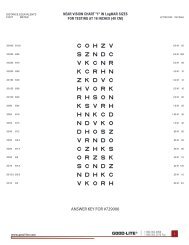101050 Stereopsis Butterfly - PDF - Good-Lite Company
101050 Stereopsis Butterfly - PDF - Good-Lite Company
101050 Stereopsis Butterfly - PDF - Good-Lite Company
Create successful ePaper yourself
Turn your PDF publications into a flip-book with our unique Google optimized e-Paper software.
The <strong>Butterfly</strong><br />
Stereo Acuity Test<br />
P/N 1010<br />
INSTRUCTIONS<br />
Vision Assessment Corporation<br />
2675 Coyle Avenue<br />
Elk Grove Village, Illinois 60007 USA<br />
Phone: 1 847 239 5889<br />
Toll Free USA: 1 866 887 9692<br />
Email: Sales@visionassessment.com<br />
Web: www.visionassessment.com<br />
© Vision Assessment Corporation 2007
INSTRUCTIONS<br />
Thank you for purchasing the Vision Assessment Corporation <strong>Butterfly</strong><br />
Stereo Acuity Test with Lea Symbols ® P/N 1010.<br />
PURPOSE<br />
This test is designed to rapidly test for amblyopia, strabismus and other<br />
binocular acuity problems using stereopsis (depth perception) for test<br />
subjects ages preschool thru adult.<br />
Depth Perception: (n) The ability to perceive spatial relationships,<br />
especially distances between objects, and three dimensions.<br />
Lea Symbols®: (n) 4 symbols, House, Circle, Square & Apple, developed<br />
by Lea Hyvärinen, MD, for screening children of all developmental abilities<br />
and languages designed to blur equally at threshold – children only see one<br />
shape when the symbol size becomes too small to see clearly.<br />
House<br />
Circle<br />
Square<br />
Apple<br />
FAMILIARIZE YOURSELF WITH THE TEST<br />
Test consists of:<br />
1. 1 booklet – 2 vectographic pages (3 Sections)<br />
Page 1 (Section A)<br />
Gross <strong>Stereopsis</strong><br />
Page 2 (Section B)<br />
10 levels of disparity for critical testing<br />
Page 2 (Section C)<br />
3 gross levels of disparity
2. 1 pair adult polarized viewers<br />
(NOT TO BE USED AS SUNGLASSES)<br />
3. 1 pair pediatric polarized viewers<br />
(NOT TO BE USED AS SUNGLASSES)<br />
4. Answer Key on back cover<br />
TESTING CONDITIONS<br />
Well-lit, glare-free area<br />
If reflections or glare on the vectographic pages can be<br />
seen, try tilting the booklet or choose another testing<br />
location<br />
ADMINISTERING THE TEST<br />
Section A<br />
1. Place the polarized viewers on the test subject<br />
2. PLEASE NOTE: IF TEST SUBJECT WEARS<br />
PRESCRIPTION GLASSES, THE POLARIZED<br />
VIEWERS SHOULD BE WORN OVER GLASSES<br />
3. Open test booklet and fold so that only Page 1 can<br />
be viewed by test subject<br />
4. Hold the booklet approximately 16 inches (40 cm)<br />
from the test subject<br />
5. A <strong>Butterfly</strong> is hidden in the dot pattern<br />
When both eyes are functioning properly the<br />
butterfly should appear as a 3-dimentional image<br />
protruding from the page<br />
If both eyes are not functioning properly the test<br />
subject will not see the image<br />
6. Ask the test subject to identify the image and trace<br />
it with his/her finger<br />
7. Exercise patience and encouragement while the<br />
test subject attempts to identify the image as many<br />
binocular test subjects rely heavily on monocular<br />
clues which do not exist in this test<br />
If test subject is unable to see the image, ask the<br />
test subject to identify the “L” & “R” at the bottom of<br />
the page. If the test subject is unable to perform<br />
this task, he/she is untestable<br />
Scoring<br />
<strong>Butterfly</strong> Seconds of arc<br />
Wings (upper) 2,000<br />
Antenna 1,100<br />
Wings (lower) 1,000<br />
Abdomen 600
Section B (For Adults)<br />
1. Turn booklet so that only Page 2 can be viewed by test subject<br />
2. Ask test subject to look at the 10 boxes each containing 4<br />
circles<br />
3. Only one circle in each box will appear to be floating or forward<br />
from the others<br />
4. Starting with box #1, ask the test subject to point to or identify<br />
(top, bottom, left or right) the circle that appears to be floating<br />
or different from the others<br />
5. Repeat last step for boxes 2-10<br />
6. When one is missed, retest the preceding box to ensure that<br />
the test subject can achieve this level and was not just<br />
guessing<br />
Scoring<br />
1. Record the level of stereopsis for the circle in the last box<br />
chosen correctly<br />
2. Refer to Answer Key on back of test booklet<br />
Section C (For Children)<br />
1. In each line – A, B & C, only one symbol appears to be floating<br />
or forward from the others<br />
2. Taking each line in order, have test subject look at Lea<br />
Symbols® at bottom of page and point to or name the symbol<br />
on each line A, B & C that appears to be floating or that is<br />
different from the others on that line. If one is missed, retest the<br />
preceding line to ensure that the test subject can achieve this<br />
level and was not just guessing<br />
Scoring<br />
CARE/HANDLING & STORAGE<br />
Clean vectographic pages with a soft, damp lint-free cloth<br />
Store closed booklet in a cool, dry place away from direct sunlight<br />
Clean polarized viewers using lens cleaner and soft, lint free cloth<br />
WARRANTY<br />
1 year manufacturer warranty from date of purchase<br />
Made in the USA<br />
www.lea-test.fi

















